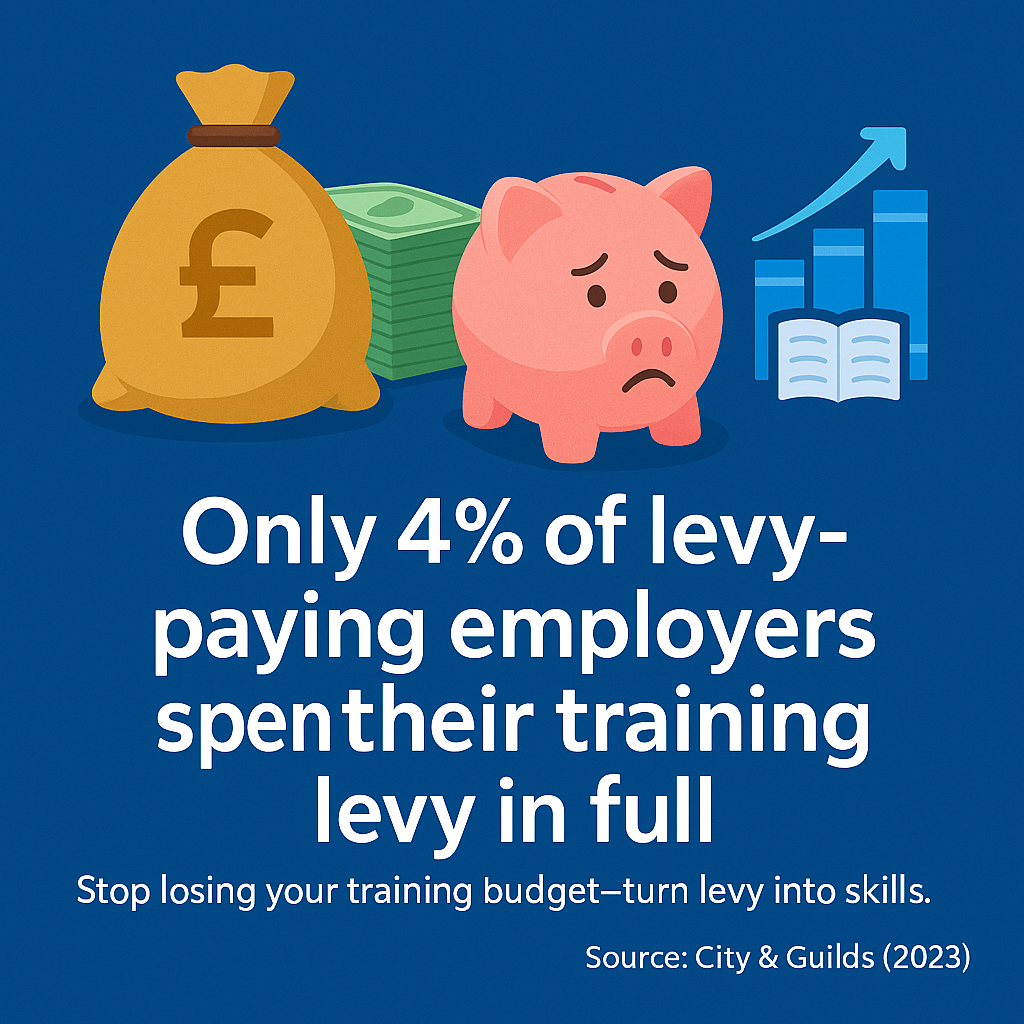- Admin User
- September 27th, 2025
The Apprenticeship Levy England – What You Need to Know (2025 Guide for Levy & Non-Levy Employers)
If you employ people in the England, you’ve likely encountered the Apprenticeship Levy. Even if you don’t pay the levy, you can still access government-funded apprenticeships with 95% (and in many SME cases 100%) of training fees covered. This guide explains what the levy is, what you pay, how much employers are using, why pots go unspent, and how non-levy employers can make the most of the system.
Who pays and how much?
Levy-paying employers are those with an annual UK pay bill above £3 million. The levy is charged at 0.5% of the pay bill, with a £15,000 annual allowance. Contributions are reported and paid monthly via PAYE and can then be drawn down to fund approved apprenticeship training.
Are companies using their funds?
In the scheme’s early years (2019), around 45% of levy-paying employers reported spending none of their pot. More recent surveys (e.g., 2023) suggest only a small minority—around 4%—spend all of their levy in a given period, while typical utilisation averages roughly 40–55%. The gap between contributions and drawdowns is reflected in several billions of pounds that have expired or been returned to the Treasury since launch.
Why do employers under-spend?
The reasons are mostly operational, not financial: programmes often run 12–36 months (perceived as too long versus just-in-time upskilling); teams can struggle to map immediate skill needs to the right standard; paperwork and compliance steps feel heavy; awareness inside organisations is patchy; there’s no clear internal “owner” for sign-ups; perceptions linger that apprenticeships are only for school-leavers; managers worry about the impact of off-the-job learning (at least 6 hours per week); and sometimes providers aren’t the right fit for delivery model or pace.
Non-levy employers: what you can get
Non-levy employers (typically SMEs) can access apprenticeship funding without paying the levy. In most cases the government funds 95% of training and assessment up to the funding band maximum, leaving the employer to contribute 5%. Since 1 April 2024, government fully funds 100% of training for SMEs where the apprentice is aged 16–21 (and some 22–24s with an EHC plan or care experience). Employers still pay wages, but tuition is covered as above. SMEs can also receive levy transfers from large employers (up to 50% of a large employer’s annual levy) to cover training costs completely.
Why should SMEs sign up?
Apprenticeships build hard-to-hire skills in-house while people remain productive; tuition costs are low (or zero with transfers), so ROI is driven largely by salary and time; structured development improves retention and progression; modern standards span Levels 2–7, including options tailored for experienced staff at Levels 4–7; and set-up is straightforward via the Apprenticeship Service (reserve funding, select a standard and provider, agree a start).
What’s stopping SMEs?
Awareness is the biggest barrier—many simply don’t know they can access 95–100% funding. Capacity planning for the 6 hours per week of off-the-job learning can also feel daunting, especially for micro-businesses. In practice, aligning off-the-job activity to live projects and planning around peak periods makes the commitment manageable and value-adding.
Getting started
Create an Apprenticeship Service account, reserve funding (for SMEs), pick an approved standard and shortlist providers, complete prior learning checks, and set a start date. A good provider will handle compliance and progress reporting; your focus is on selecting candidates and supporting them in role.
Summary
Large UK employers pay 0.5% of payroll above a £3m threshold into the Apprenticeship Levy and can reclaim it for approved training, yet most spend only part of their pot and few exhaust it. Under-utilisation is driven by programme length perceptions, standard fit, admin burden, limited internal bandwidth, and outdated views—issues that are solvable with ownership and planning. Non-levy employers can access 95% funding (and often 100% for 16–21s), plus levy transfers, making apprenticeships one of the most cost-effective ways to build capability—provided they understand the rules and plan the six hours per week of off-the-job learning. Treat apprenticeships as a strategic investment, not a compliance chore, and convert what can look like a tax into a predictable pipeline of skills for both large employers and SMEs.

